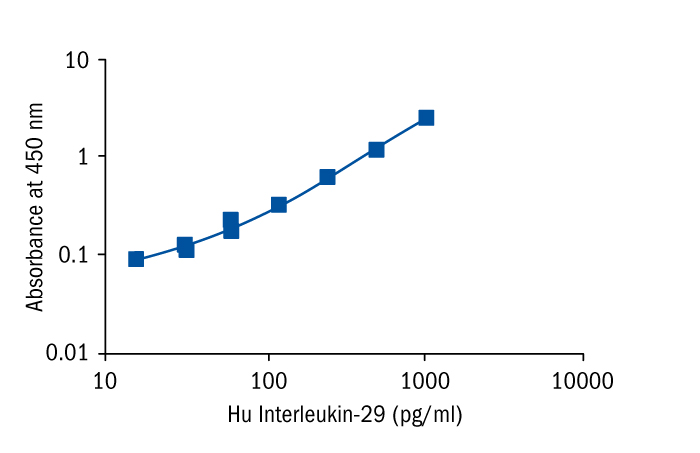Type
Sandwich ELISA, Biotin-labelled antibody
Applications
Serum, Plasma-EDTA, Cell culture supernatant
Sample Requirements
50 µl/well
Shipping
At ambient temperature. Upon receipt, store the product at the temperature recommended below.
Storage/Expiration
Store the complete kit at 2–8°C. Under these conditions, the kit is stable until the expiration date (see label on the box).
Calibration Curve
Calibration Range
15.6–1000 pg/ml
Limit of Detection
2 pg/ml
Research topic
Cytokines and chemokines and related molecules
Summary
Interleukin-29 (IL-29) is a protein of the helical cytokine family and is a type III interferon sharing many functions with the type I family of interferons. The IL-29 gene is found on chromosome 19 in humans. It is also known as IFN-λ1 and is highly similar in amino acid sequence to the IL-28, the other type III interferon. IL-29 does not bind the IFN-α/β receptor, but instead signals through a receptor composed of the IL-28R1 and IL-10R2 subunits. Initial characterizations of the receptor demonstrated that it has a ubiquitous tissue distribution and is expressed on most non-hematopoietic cells. Generation of native IL-29 is achieved by monocytes and dendritic cells in response to viral infection and stimulation with toll-like receptor ligands. IL-29 plays an important role in host defenses against microbes and its gene is highly upregulated in cells infected with viruses. IL-29 has significant antiviral activity and immunoregulatory properties and appears to inhibit T helper-2 (Th2) responses regarding inhibition of IL-13 production, compared with IL-4 or IL-5. The antiviral activities of IL-29 include the upregulation of MHC Class I expression on the cell surface and the expression of PKR. The ligand/receptor complex seems to signal through the Jak-STAT pathway.
Find documents for the lot
Example Instructions for Use (RUO)
Example Instructions for Use (RUO)
Safety Information (RUO)
MSDS (RUO)

